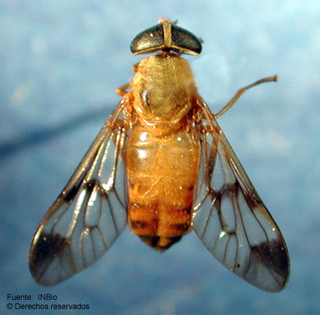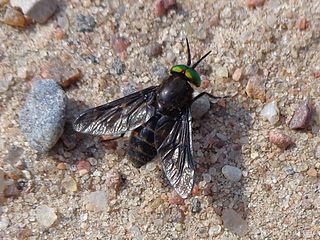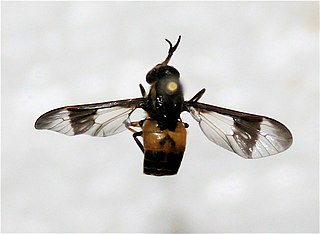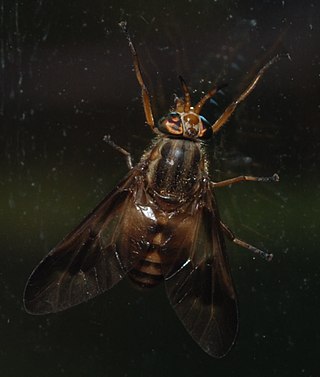
Horse-flies and deer flies are true flies in the family Tabanidae in the insect order Diptera. The adults are often large and agile in flight. Only female horseflies bite land vertebrates, including humans, to obtain blood. They prefer to fly in sunlight, avoiding dark and shady areas, and are inactive at night. They are found all over the world except for some islands and the polar regions. Both horse-flies and botflies (Oestridae) are sometimes referred to as gadflies.

Deer flies are bloodsucking insects considered pests to humans and cattle. They are large flies with large brightly coloured compound eyes, and large clear wings with dark bands. They are larger than the common housefly and smaller than the horse-fly. There are 250 species of deer fly in the genus Chrysops. Their distribution is worldwide, though they have not been reported in Iceland, Greenland, or Hawaii.
Chrysops niger, the black deer fly, is a fly of about 8–10.5 millimetres (0.31–0.41 in) length, with a mostly black body with some white hairs, and having wings which are barred with black. They are active from May to September around areas of marsh.
Cornelius Becker Philip (1900–1987) was an American entomologist, noted for assigning comedic names to species he described.

Chrysops caecutiens, common name splayed deer fly, is a species of horse fly belonging to the family Tabanidae. It is also known by the colloquial name Scotch cleg.

Diachlorus ferrugatus, commonly known as the yellow fly in the United States or doctor fly in Belize, is a species of highly aggressive biting horse-fly of the family Tabanidae native to North and Central America to Costa Rica.

Chrysops sepulcralis is a species of 'horse flies' belonging to the family Tabanidae.
Chrysops lateralis is a species of deer fly in the family Tabanidae.

Chrysopsinae is an insect subfamily in the family Tabanidae commonly known as deer flies or sheep flies and are bloodsucking insects considered pests to humans and cattle. They are large flies with large brightly-coloured compound eyes, and large clear wings with dark bands. They are larger than the common housefly and smaller than the horse-fly.

Chrysops geminatus is a species of deer fly in the family Tabanidae.
Chrysops divisus is a species of deer fly in the family Tabanidae.

Chrysops flavidus is a species of deer fly in the family Tabanidae. The species is identifiable by its yellow legs.
Chrysops furcatus is a species of deer fly in the family Tabanidae.
Chrysops excitans is a species of deer fly in the family Tabanidae.

Chrysops vittatus is a species of deer fly in the family Tabanidae.
Chrysops aestuans is a species of deer fly in the family Tabanidae.

Pangoniinae is a subfamily of horse-flies in the order Diptera, containing at seven tribes and over 40 genera.
Chrysops provocans is a species of deer fly in the family Tabanidae.

Chrysopsini is a tribe of horse and deer flies in the family Tabanidae.










